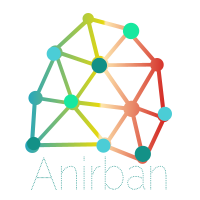Research Ideas: Small Population Contagion
We approach the problem of prediction from the perspective of social network analysis. We emphasize that unless we incorporate the network structure underlying a country, the spread of the disease cannot be accurately modeled using standard epidemiological models. The basis of the model in this document is the standard epidemiological model SIR. However, as we are concerned about predicting the spread of infection within a confined space, for example an office space, several assumptions of SIR models will be violated if we want to apply that directly onto such a problem. As we will be dealing with an extremely small population, with entry restrictions (e.g. anyone with symptoms are not allowed to enter the office), we will simulate the spread of the infection based on the following modified model.
Any smart contact tracing system will be able to judge the vulnerability of the person who has encountered a carrier by using the following ranking function CON-VR (Contagiousity- Vulnerability Rating) of a person $i$, when she meets the carrier $j$ at location $L$. Let the carrier $j$ leaves the location at time $j_d$ and the contact $i$ arrives at the location at time $i_a$ and $A = j_d - i_a$
$$
V_{ij} = [a(F_{L}^m)+b(D^n)+c(T^p)+d(C_{ij}^q)+h(E_{L}^r)].(G_{j}^s)
$$
Where
\begin{align*}
V_{ij} &= \text{Vulnerability when}~ i ~\text{met}~ j\\
F_{L} &= \text{Number of Fomites at location L}\\
D &= \text{Duration of the meet between the two persons} = \dfrac{A + |A|}{2}\\
T &= \text{Time difference between carrier's leaving and contact's appearing} = \dfrac{-A + |-A|}{2}\\
C_{ij} &= \text{Minimum closeness between them}\\
E_{L} &= \text{Environment at location L}\\
G_{j} &= \text{How long ago was the carrier got infected}\\
a,b,c,d &= \text{Weights associated with the parameters}\\
m,n,p,q,r &= \text{Elasticity of the parameters}
\end{align*}
If the contact $i$ comes in contact with more than one contacts $j_k,~k=1,2,3...$, then Resultant Vulnerability of the contact $i$ will be computed as $V_i = \max_{k \in \{1,2,3,..\}} V_{ij_k}$.
Model of Contagion
As we are working with a small population, we cannot assume that the compartments are continuous. Hence, we cannot use differential equations for the modified model.
Let us assume that within the population $N$ of the space, there are some people who have not come into contact with any carrier, and are not infected either. This is the susceptible group of people. We denote the size of the group as $S$. Similarly, size of the group of people who have come into contact with some infected or carrier outside the office space will be denoted as $C$. Finally, the size of the group who has already been infected and recovered/immune will be denoted as $R$.
From the vulnerability of any person $i$, we can construct a probability of that person getting infected when (s)he is coming in contact with a carrier $j$ at a location $L$. From the CON-VR function, we can see that $V_{ij}$ is a random variable. Let us denote $$v = \min(V_{ij})~ \forall~ i,j ~\text{and}$$ $$V = \max(V_{ij})~ \forall~ i,j$$
Now we will assume that the probability of contagion is 0 when vulnerability is $v$ and the same is 1 when the vulnerability is $V$. Based on that, we can construct the probability of infection when a person $i$ meets a carrier $j$ as $$P_{ij} = \dfrac{V_{ij} - v}{V - v}$$ We will further assume that at a given time period, $M$ interactions are happening between a susceptible person and a carrier. $M$ will depend on the network structure, which will be taken care of by the simulation.
Using the formulation of the probability of infection, we can now model the infection dynamics as
\begin{align*}
S_{t + \Delta t} - S_t &= -M.\sum_M P_{ij}\\
C_{t + \Delta t} - C_t &= M.\sum_M P_{ij} - \gamma C\\
R_{t + \Delta t} - R_t &= \gamma C
\end{align*}
Conclusion
CON-VR, once trained, will give the accurate vulnerability rating using XACT contact tracing solution, and that in turn, will provide us the $P_{ij}$. Once we know $P_{ij}$ for every carrier $j$ at every location $L$, we will run the simulation and find out how the infection is spreading with and without intervention.
